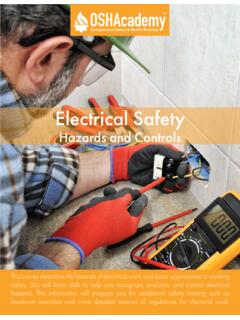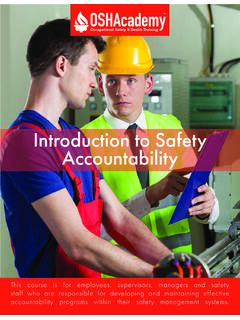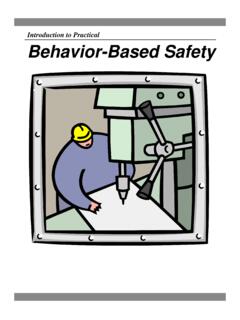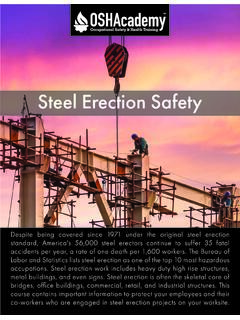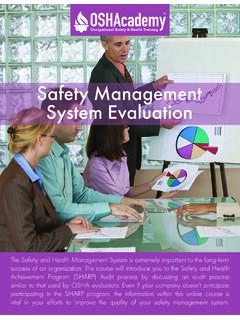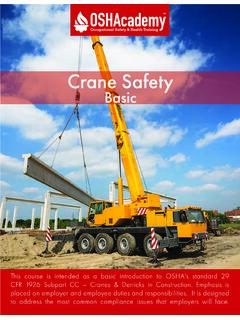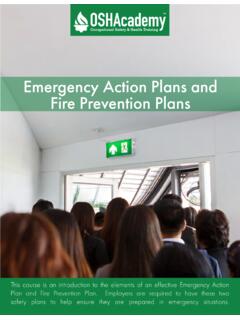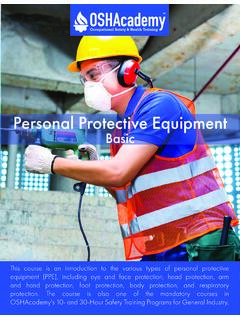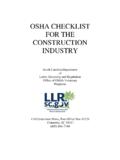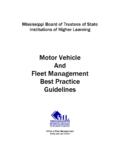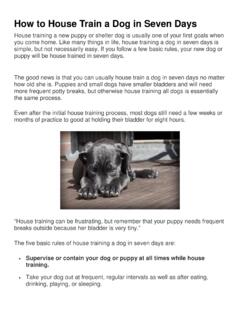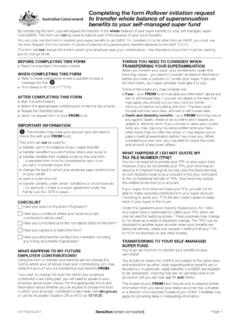Transcription of Powered Industrial Truck Safety - OSHAcademy
1 This course has general information about the classes and divisions of forklifts commonly used in the workplace. It also covers the principles necessary to understand for safe loading, transferring loads, and unloading. Forklift operator training requirements and general best practices in operating, servicing and maintaining forklifts are discussed. The hazards associated with operating forklifts in enclosed areas and construction sites are also Industrial Truck Safety This page intentionally blank OSHA cademy Course 725 Study Guide Powered Industrial Trucks Safety Copyright 2020 Geigle Safety Group, Inc. No portion of this text may be reprinted for other than personal use. Any commercial use of this document is strictly forbidden. Contact OSHA cademy to arrange for use as a training document. This study guide is designed to be reviewed off-line as a tool for preparation to successfully complete OSHA cademy Course 725.
2 Read each module, answer the quiz questions, and submit the quiz questions online through the course webpage. You can print the post-quiz response screen which will contain the correct answers to the questions. The final exam will consist of questions developed from the course content and module quizzes. We hope you enjoy the course and if you have any questions, feel free to email or call: OSHA cademy 15220 NW Greenbrier Parkway, Suite 230 Beaverton, Oregon 97006 +1 (888) 668-9079 Disclaimer This document does not constitute legal advice. Consult with your own company counsel for advice on compliance with all applicable state and federal regulations. Neither Geigle Safety Group, Inc., nor any of its employees, subcontractors, consultants, committees, or other assignees make any warranty or representation, either express or implied, with respect to the accuracy, completeness, or usefulness of the information contained herein, or assume any liability or responsibility for any use, or the results of such use, of any information or process disclosed in this publication.
3 GEIGLE Safety GROUP, INC., DISCLAIMS ALL OTHER WARRANTIES EXPRESS OR IMPLIED INCLUDING, WITHOUT LIMITATION, ANY WARRANTIES OF MERCHANTABILITY OR FITNESS FOR A PARTICULAR PURPOSE. Taking actions suggested in this document does not guarantee that an employer, employee, operator or contractor will be in compliance with applicable regulations. Ultimately every company is responsible for determining the applicability of the information in this document to its own operations. Each employer s Safety management system will be different. Mapping Safety and environmental management policies, procedures, or operations using this document does not guarantee compliance regulatory requirements. Revised: September 2, 2020 This page intentionally blankCourse 725 Contents Course Introduction .. 1 Module 1: Types of Powered Industrial Trucks (PITs) - Forklifts .. 2 PIT Classifications .. 2 Class I Electric Motor Rider 2 Class II Electric Motor Narrow Aisle Trucks.
4 4 Class III Electric Motor Hand Trucks or Hand/Rider Trucks .. 4 Class IV Internal Combustion Engine Trucks (Solid/Cushion Tires) .. 6 Class V Internal Combustion Engine Trucks (Pneumatic 6 Class VI Electric and Internal Combustion Engine Tractors .. 7 Class VII Rough Terrain Forklift Trucks .. 7 Power 8 Attachments .. 8 Hazards .. 9 Selecting the Right Forklift for the Environment .. 10 Module 2: Operator Training .. 13 Requirements .. 13 Trainer Qualifications .. 14 Training Topics .. 14 General Forklift Training Topics .. 14 Workplace-Specific Training Topics .. 15 Refresher Training .. 16 Unnecessary Retraining .. 16 Course 725 Retraining Topics .. 17 Performance Test for Forklift Operators .. 17 Operator Certification .. 19 Maintaining Records .. 19 Module 3: How a Forklift Works .. 20 Driving a Forklift: Different than Driving a Car .. 20 Forklift Safety Measures .. 20 Overhead Guards .. 20 Mast .. 21 Operator Restraints .. 21 Principles of Lifting Loads.)
5 21 Fulcrum Principle .. 22 Stability Triangle .. 22 Center of Gravity (CG) .. 22 Load Composition .. 22 Weight, Size, and Position .. 23 Capacity Plates .. 23 Safe Load Capacity .. 24 Other Factors Affecting Capacity .. 24 .. 25 Raising the Load Can Create Instability .. 25 Module 4: Safe Forklift Operations .. 29 Minimum Age Requirement .. 29 Pre-Use Inspection .. 29 Course 725 Traveling .. 31 Driving on Ramps and Grades .. 32 Driving onto Trucks, Trailers, and Railroad Cars .. 32 Module 5: Safe Forklift Operations (Continued) .. 36 Loading and Unloading the Forklift .. 36 Leaving a Forklift 38 Lifting and Lowering 39 Traffic Patterns .. 40 Workplace Conditions .. 41 Housekeeping .. 42 Carbon Monoxide .. 42 Maintenance Records .. 43 Module 6: Forklift Maintenance .. 44 Out of Service and Required Check Intervals .. 44 Corrective Maintenance .. 44 Preventive Maintenance .. 44 Safety in the Maintenance Area .. 45 Modifying Forklifts .. 46 Cleaning 46 Refueling: Gasoline and Diesel.
6 46 Refueling: Liquid Petroleum 47 Operator s Daily Checklist: Gas or LPG Forklift .. 49 Module 7: Forklift Maintenance (Continued) .. 52 Electric Forklifts .. 52 Course 725 Recharging Electric Forklifts .. 52 The Battery Charging Area .. 52 Battery Charging and Changing Procedures .. 53 Battery Maintenance .. 56 Sulfuric Acid Splash .. 57 Emergency Procedure in the Event of an Acid Splash .. 58 Hydrogen Gas .. 60 Operator s Daily Checklist: Electric Forklift .. 61 Endnotes .. 64 Course 725 Copyright 2020 Geigle Safety Group, Inc. Page 1 of 64 Course Introduction A Powered Industrial Truck is defined as a fork Truck , tractor, platform lift Truck , motorized hand Truck , and other specialized Industrial trucks Powered by electric motors or internal combustion engines. Powered Industrial trucks, often called forklifts or lift trucks, can be ridden or controlled by a walking operator. As you can see in the photo at the right, forklifts have been around a long time and they ve gone through some significant design improvements.
7 Even though 75% of forklift drivers are considered properly trained, every year over 100 workers are killed and 35,000 are seriously injured in forklift mishaps. Many forklift-related incidents, over 30%, involve pedestrians, not operators. In fact, the #1 most common accident is hitting or running over a pedestrian. This course contains general information about: the kinds of forklifts commonly available the principles of physics that allow a forklift to lift and move heavy loads safely forklift operator training requirements basic operator Safety rules hazardous locations where carbon monoxide is a problem or a special forklift is needed Safety while servicing a forklift This course is not designed to be a substitute for OSHA-required hands-on forklift operator training in the operation of specific forklifts. The course does not include Safety regarding compressed air or nonflammable compressed gas-operated Industrial trucks, farm vehicles, vehicles intended primarily for earth moving, or over-the-road hauling.
8 Course 725 Copyright 2020 Geigle Safety Group, Inc. Page 2 of 64 Module 1: Types of Powered Industrial Trucks (PITs) - Forklifts PIT Classifications A forklift is a type of Powered Industrial Truck (PIT) covered by OSHA standards. Like other Powered Industrial trucks, its purpose is to move, carry, push, pull, and lift a material load then stack it or place it in a storage rack (tier). Forklifts come in many sizes and capacities. They can be Powered by batteries, propane, gasoline, or diesel fuel. Some are designed to be used in a hazardous location or atmosphere where an ordinary forklift might cause a fire or explosion. Powered Industrial trucks are classified into seven types based on their characteristics. Each type of Powered Industrial Truck has its own unique characteristics and some inherent hazards. Powered Industrial trucks may operate on almost any surface, from smooth level floors to rocky uneven ground. Different trucks are designed and manufactured to operate in different work environments.
9 Class I Electric Motor Rider Trucks These forklifts are equipped with either cushion or pneumatic tires. The cushion tired lift trucks are intended for use indoors on smooth floors. The pneumatic tired models are suitable for dry outdoor areas. These vehicles are Powered by Industrial batteries and are generally found from the loading dock to the storage facility. They should also be used in areas where air quality factors need to be considered. Course 725 Copyright 2020 Geigle Safety Group, Inc. Page 3 of 64 Quiz Instructions After each section, there is a quiz question. Make sure to read the material in each section to discover the correct answer to these questions. Circle the correct answer. When you are finished go online to take the final exam. This exam is open book, so you can use this study guide. 1. Powered Industrial trucks are classified into seven types based on _____. a. the area of use b. their characteristics c. size d.
10 The number of wheels Course 725 Copyright 2020 Geigle Safety Group, Inc. Page 4 of 64 Class II Electric Motor Narrow Aisle Trucks These forklifts are suitable for companies that have narrow aisles in their facilities to maximize the use of storage space. Class II vehicles have unique features that are designed to minimize the space occupied by the Truck while improving speed and efficiency. Class III Electric Motor Hand Trucks or Hand/Rider Trucks These trucks are hand controlled by the operator who is in front of the Truck . The operator controls the lift Truck using a steering tiller. All the controls are mounted on the top of the tiller Course 725 Copyright 2020 Geigle Safety Group, Inc. Page 5 of 64 which is moved side to side to steer the Truck . Class III vehicles are battery Powered with the smaller capacity units using Industrial batteries. 2. Which forklift class uses a steering tiller to control the direction of the forklift?
